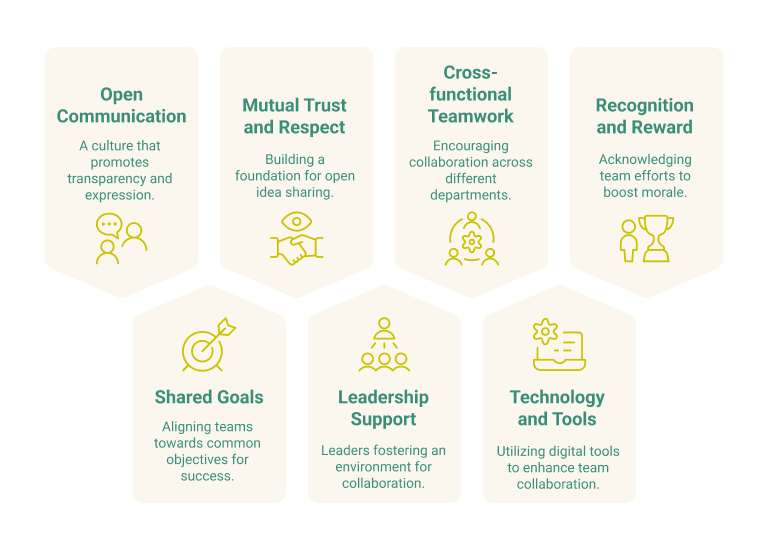project management · Mar 7, 2025
Create a Collaborative Culture in the Workplace

What is a Collaborative Culture?
A collaborative culture in the workplace is an environment where employees actively work together, share ideas, and support each other to achieve common goals.
Instead of working in silos, team members in a collaborative culture communicate openly, contribute their strengths, and leverage each other's expertise to enhance overall productivity and innovation.
A collaborative culture fosters trust, transparency, and inclusivity, ensuring that everyone feels valued and empowered to contribute their best work.
7 Features of a Collaborative Culture

1. Open Communication
A culture of open communication ensures that employees feel comfortable expressing their thoughts, concerns, and ideas without fear of criticism. When communication is transparent and open, teams can avoid misunderstandings and improve overall efficiency.
Organizations like Netflix encourage open feedback loops where employees are empowered to share constructive criticism, leading to stronger team dynamics and innovation. Companies can foster open communication by promoting active listening, encouraging regular feedback sessions, and utilizing digital communication tools that keep everyone informed.
2. Shared Goals
Collaboration thrives when teams work toward a common purpose. Shared goals align employees on clear objectives, ensuring that everyone is working toward the same vision.
Google's implementation of OKRs (Objectives and Key Results) helps employees see how their contributions impact the company's overall success.
By setting measurable, transparent, and achievable goals, organizations can drive collective motivation and accountability, making teamwork more effective and meaningful.
3. Mutual Trust and Respect
Trust is the foundation of successful collaboration. A workplace built on mutual trust and respect encourages employees to openly share ideas without fear of being dismissed or judged.
When team members value each other's contributions, they are more likely to collaborate effectively. Companies like Salesforce emphasize psychological safety, where employees feel secure taking risks and voicing their opinions.
Trust can be cultivated through consistent leadership, fair decision-making, and fostering a culture of inclusivity where all voices are heard.
4. Leadership Support
Strong leadership plays a crucial role in fostering a collaborative culture. Leaders who lead by example, encourage teamwork, and provide necessary resources create an environment where collaboration flourishes.
At Pixar, leadership actively promotes open dialogue and constructive feedback, allowing creative teams to thrive together. Leaders can support collaboration by being approachable, ensuring clear communication of company values, and recognizing the efforts of employees who contribute to team success.
5. Cross-functional Teamwork
Organizations must break down silos and promote cross-functional teamwork to encourage innovation and efficiency. When different departments work together, they bring unique perspectives that lead to more creative problem-solving.
Tesla is known for its cross-functional collaboration between engineers, designers, and production teams, ensuring seamless innovation. Encouraging interdepartmental projects, hosting knowledge-sharing sessions, and fostering a mindset of collective ownership can help teams collaborate more effectively across various functions.
6. Technology and Tools for Collaboration
In today's digital-first workplace, collaborative technology is essential to keeping teams connected.
Tools like Quire, Slack, and Microsoft Teams facilitate communication, project management, and real-time collaboration, ensuring that employees can work together efficiently, even in remote or hybrid environments.
Investing in the right technology allows teams to streamline workflows, track progress, and eliminate barriers to communication, making collaboration more seamless and productive.
7. Recognition and Reward System
A workplace that values collaboration should actively recognize and reward team efforts. Employee recognition programs boost morale and reinforce positive behaviors, motivating employees to engage in teamwork.
Companies like LinkedIn have peer recognition programs where employees acknowledge colleagues who contribute to shared success. Whether through bonuses, public appreciation, or career growth opportunities, rewarding collaborative efforts fosters a culture where teamwork is celebrated and encouraged.
Challenges to Creating a Successful Collaborative Culture
Despite the benefits, building a collaborative culture isn't always easy. Some common challenges in the workplace include:
- Lack of Clear Communication – If employees do not know how or when to communicate, team collaboration suffers.
- Resistance to Change – Employees accustomed to working independently may struggle to embrace teamwork.
- Unclear Goals – Without well-defined objectives, team members may pull in different directions.
- Siloed Departments – When teams operate in isolation, cross-functional collaboration becomes difficult.
- Ineffective Leadership – If leaders do not encourage collaboration, employees are less likely to engage in teamwork.
- Insufficient Collaboration Tools – A lack of proper tools makes communication and project management cumbersome.
Recognizing these challenges is the first step in overcoming them. By addressing these collaboration barriers head-on, organizations can lay the foundation for a truly collaborative workplace.
8 Ways to Create a Collaborative Culture
Organizations must implement strategic initiatives to build a collaborative culture in the workplace successfully. Here are eight effective ways to foster collaboration:
1. Establish Shared Goals
Collaboration is most effective when employees work toward a common goal. Clearly defined and measurable goals ensure alignment, giving teams a sense of direction and enabling them to cooperate more effectively in a collaborative workplace.
Companies like Google foster collaboration by setting OKRs (Objectives and Key Results), ensuring that every team member understands how their work contributes to broader company goals.
When employees see how their tasks connect to the bigger picture, they become more motivated and engaged in teamwork.
2. Choose Collaborative Leaders
Leadership plays a crucial role in setting the tone for collaboration. Collaborative leaders encourage teamwork, actively listen, and provide opportunities for employees to contribute ideas.
At Pixar, leadership fosters an open, collaborative culture where creative teams can freely share feedback and suggestions. This approach ensures that innovation is a collective effort rather than an individual pursuit.
Leaders who model collaboration inspire their teams to do the same.
3. Foster Open Communication
Encouraging transparent and open communication is essential for cultivating a collaborative culture where employees share ideas freely and collaborate effectively.
Without a structured communication strategy, teams may struggle with misunderstandings and inefficiencies. Companies like Buffer practice radical transparency by openly sharing company decisions and financial data with employees, creating a sense of trust and inclusivity.
Digital tools like Slack, Microsoft Teams, and Quire enhance communication by providing real-time chat and file-sharing capabilities, ensuring everyone stays informed and engaged.
4. Break Down Departmental Silos
Organizations must encourage interdepartmental collaboration by breaking down barriers between teams to foster a collaborative culture.
At Tesla, engineers, designers, and production teams work closely together, ensuring innovation flows seamlessly across departments. When employees from different backgrounds collaborate, they bring fresh perspectives and solutions to the table.
Leaders can facilitate this by organizing interdepartmental projects, rotating employees across teams, and fostering a culture where sharing knowledge is valued.
5. Provide the Right Collaboration Tools
Using collaboration-friendly technology streamlines teamwork and fosters a collaborative culture by ensuring that everyone remains on the same page.
Companies that leverage project management tools like Quire, Asana, or Trello see improved efficiency, as these platforms enable real-time task tracking, progress visualization, and seamless communication.
For example, Quire's nested task list structure allows teams to break down complex projects into manageable steps, ensuring clarity in responsibilities and deadlines.
6. Encourage Team-building Activities
Regular team-building activities help employees build trust, which in turn fosters a collaborative culture among them.
Companies like Zappos host retreats, game nights, and team outings to strengthen relationships and create a more connected workforce.
Even virtual teams can engage in activities like online escape rooms or virtual coffee breaks to foster personal connections. When employees feel personally connected to their colleagues, they are more likely to collaborate effectively and support each other in achieving shared goals.
7. Reward Collaborative Efforts
Recognizing and rewarding teamwork reinforces a collaborative culture and encourages employees to contribute their best.
Many organizations implement peer recognition programs where employees can acknowledge their colleagues' contributions.
For example, LinkedIn has an internal initiative called "InDays," where employees collaborate on social impact projects outside of work responsibilities. Rewarding employees for their teamwork—whether through bonuses, public recognition, or career development opportunities—encourages long-term collaboration in the workplace.
8. Provide Continuous Learning and Development
Workshops, training sessions, and mentorship programs help employees develop the skills needed to thrive in a collaborative culture and adapt to dynamic work environments.
IBM, for example, invests heavily in leadership training that emphasizes teamwork, ensuring its workforce remains adaptable and engaged. Providing learning opportunities such as conflict resolution training, active listening workshops, and group problem-solving exercises can significantly enhance team dynamics and collaboration.
Build a Collaborative Culture with Quire
Collaboration thrives when teams have the right tools to facilitate communication, task management, and project tracking. Quire is designed to enhance teamwork by offering:
- Real-time Task Collaboration – Teams can create, assign, and track tasks seamlessly.
- Nested Task Management – Break down complex projects into smaller, manageable tasks.
- Integrated Communication – With built-in comments and file-sharing features, teams can discuss ideas directly within tasks.
- Flexible Workflows – Whether using Kanban boards, lists, or Gantt charts, teams can customize their workflow for optimal productivity.
- Seamless Integrations – Quire integrates with tools like Google Calendar, Slack, and Zoom, ensuring smooth communication across platforms.
By leveraging Quire, organizations can bridge communication gaps, align goals, and create a truly collaborative work environment that enhances productivity and innovation.
Conclusion
Building a collaborative culture requires intention, effort, and the right strategies. By addressing key challenges and implementing best practices, organizations can create an environment where teamwork flourishes. And with tools like Quire, collaboration becomes effortless, empowering teams to achieve their goals together.

